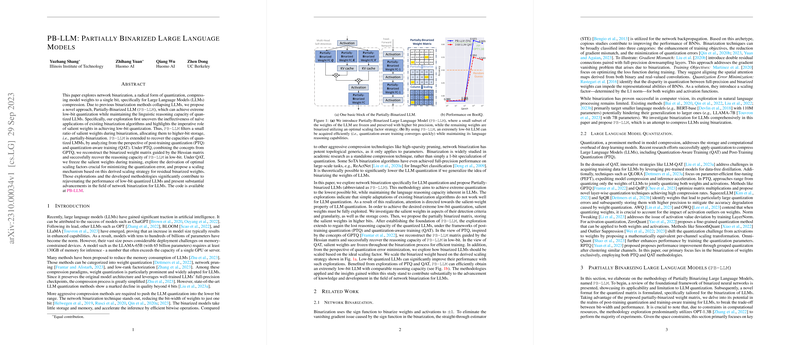Partially Binarized LLMs: A Comprehensive Examination
The proliferation of LLMs like GPT, BERT, and their variants have propelled advancements across various domains in artificial intelligence. These models, empowered by tens or hundreds of billions of parameters, often herald impressive performance but are constrained by their significant memory and computational demands. This has ignited interest in various model compression techniques, among which weight quantization holds particular significance. The paper “PB-LLM: Partially Binarized LLMs” proposes a novel compression methodology employing a partially binarized approach to LLMs, potentially bridging the gap between extreme quantization and performance retention.
Methodology Synopsis
The paper challenges the conventional quantization paradigm, which traditionally reduces weights to a uniformly low bit-width. It introduces the concept of Partially-Binarized LLM (PB-LLM), a two-phase strategy where the majority of model weights are binarized to one bit while maintaining a small fraction of salient weights in higher precision. The identification of salient weights, determined primarily by magnitude, plays a crucial role in this selective storage strategy. This is grounded in recognizing that certain weights disproportionately contribute to the model's overall reasoning capabilities.
The binarization framework is investigated through two primary avenues: Post-Training Quantization (PTQ) and Quantization-Aware Training (QAT). These avenues aid in delineating strategies to recover and maintain the model's linguistic reasoning ability post-binarization.
- PTQ with PB-GPTQ: This method extends the GPTQ framework to a partially binarized setting. The technique quantizes weights iteratively, appending a compensation mechanism to the non-salient weights after binarization. The exploration of PB-GPTQ unveils its efficacy in quantifying models like OPT-1.3B and LLaMA-7B with preserved reasoning capability, conditional on a judicious choice of salient weight ratios.
- QAT Strategies: Implementing Quantization-Aware Training involves freezing salient weights and employing optimally derived scaling factors from binarized weights. These strategies not only facilitate efficient post-binarization training by conserving computational overhead but also underscore the rapid convergence capabilities intrinsic to PB-LLM.
Empirical Evaluation and Results
The paper substantiates its claims by subjecting PB-LLM to a series of rigorous evaluations on renowned tasks, including BoolQ, PIQA, and more, assessing both its reasoning prowess and generalization abilities. Notably, the results indicate that by retaining even a modest percentage of salient weights, the PB-LLM can achieve performances akin to higher-bit settings, with the appropriate scaling and frozen weight strategies employed adeptly.
Key empirical benchmarks on common sense reasoning tasks reveal that PB-LLM compares favorably against other recent methodologies in the 4-bit quantization domain. The PB-GPTQ framework, despite extreme low-bit conditions, offers a promising balance between reduced bit-widths and retained factual reasoning capability, especially with quantization-aware training further enhancing outcomes.
Implications and Future Trajectories
The implications continue to unfold, both in the capacity of LLMs to operate efficiently in resource-constrained environments and in expediting deployment in real-world applications. Practically, the methodologies foster promising avenues for reducing the operational costs of deploying advanced AI systems on edge devices. Theoretically, this work may inaugurate further research into granular quantization strategies and latent-sparse learning paradigms that bolster efficient AI.
In conclusion, the PB-LLM framework carves a significant niche in the evolving landscape of machine learning model optimization. Through astute implementation and insightful innovations, this research lays the groundwork for subsequent explorations in network binarization, potentially catalyzing a more efficient integration of LLMs into myriad applications globally. This work, while ground-breaking in its present form, also gestures toward uncharted explorations in leveraging binarization for deep language understanding in the realms of artificial intelligence.
